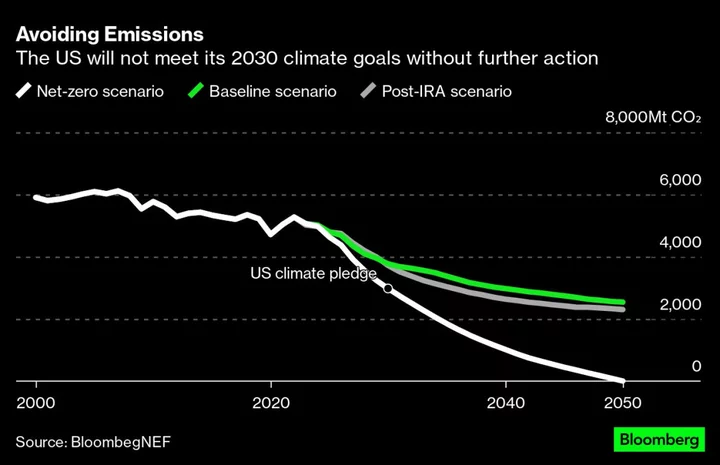US President Joe Biden’s signature climate law, the Inflation Reduction Act, could slash US greenhouse gas emissions in half by 2050 but not come close to eliminating them, according to a new analysis from BlooombergNEF.
The law’s $369 billion in financial incentives will speed up the transition to renewable power and electrified transportation, driving the country’s emissions down from 5.3 gigatons last year to 2.3 gigatons at mid-century. Climate scientists have shown that global emissions need to peak before 2025 and approach zero by mid-century to stave off the worst effects of climate change. The report's authors say that in addition to the many carrots the IRA provides to clean energy technologies, the US government will also have to use some sticks, such as putting a price on emissions or phasing out sales of gas-burning cars by a set date.
The US federal government “is kind of allergic to sticks,” said Tom Rowlands-Rees, head of BNEF’s North America Research. That’s why clean energy support takes the form of incentives and tax credits. “Our analysis suggests that those incentives can only get you so far,” he said.
The analysis represents BNEF’s first attempt to forecast how the IRA, passed last year, will affect energy-related emissions across the entire US economy, rather than specific industries such as renewable power. While the law will have a significant impact on some technologies — boosting sales of electric cars to the point where they make up 63% of the US passenger fleet by 2040 — it won’t put the US on track to meet the country’s commitments under the 2015 Paris Agreement, which sought to limit global warming to less than 1.5C or, failing that, no more than 2C.
“We reasonably did not expect that policies alone would automatically get us to net zero. What was surprising was that it was a much smaller impact in some sectors,” said Tara Narayanan, BNEF’s senior associate for US Power and a report author.
The IRA will have little effect on heavy industries, such as steel, that can’t easily run on electricity. For example, BNEF predicts that green hydrogen, which can be burned without producing carbon dioxide, won’t be cheaper than existing industrial energy sources until the 2040s, despite the IRA’s incentives.
Carbon capture and storage, long a Holy Grail for power plants and heavy-polluting industries, performs well in the analysis. Natural gas power plants that have CCS start to become competitive against plants without it, as tax credits make up for the added cost of equipment and operations. That will make CCS-fitted gas plants a workable alternative to wind and solar power, which together are forecast to account for 64% of electricity generation in 2050.
To close the emissions gap, BNEF recommends extending tax credits for hydrogen and carbon capture beyond their current 2033 expiration date and adopting incentives for hydrogen use, not just production. The research group also calls for prioritizing the construction of new power lines that will be needed as more vehicles and industries electrify and speeding up the government approval process for solar plants, wind farms and large-scale batteries.
“We need to be realistic about what one piece of legislation can achieve,” Rowlands-Rees said. “It’s just the first step of hopefully more steps.”

